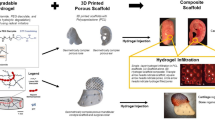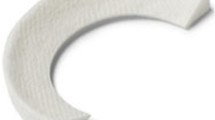Abstract
Purpose
The purpose of the study was to investigate the effect of dermatan sulphate (DS) addition to biodegradable methoxy polyethylene glycol (MPEG) substituted polylactide-co-glycolic acid (PLGA) scaffolds for cartilage repair in vitro and in vivo.
Methods
Human chondrocytes from eight patients undergoing anterior cruciate ligament reconstruction were isolated and cultured in 5% oxygen on MPEG-PLGA scaffolds ± DS for one, three, seven and 14 days. Analyses were performed using quantitative gene expression analysis for chondrogenic and cell attachment markers. An osteochondral drill hole defect was created in the intertrochlear groove of the distal femur in 20 New Zealand white rabbits (defects n = 20). When bleeding was observed, the defects were treated with MPEG-PLGA scaffolds ± DS. Twelve weeks after surgery the rabbits were sacrificed and the defects were analysed using histological grading with O’Driscoll scoring.
Results
DS addition to MPEG-PLGA scaffolds resulted in a significant upregulation of fibronectin gene expression on day 1. No differences were observed in chondrogenic gene expression. There were no differences between the two groups in histological grading (+DS 10.3 and −DS 9.6).
Conclusions
Upregulation of fibronectin in vitro indicating early cell-scaffold interaction and attachment did not result in improved cartilage repair in an osteochondral defect model in rabbits.



Similar content being viewed by others
References
Buckwalter JA, Mankin HJ (1997) Articular cartilage. Part II: degeneration and osteoarthrosis, repair, regeneration, and transplantation. J Bone Joint Surg 79(4):612–632
Bedi A, Feeley BT, Williams RJ 3rd (2010) Management of articular cartilage defects of the knee. J Bone Joint Surg Am 92(4):994–1009
Kreuz PC, Steinwachs MR, Erggelet C, Krause SJ, Konrad G, Uhl M, Südkamp N (2006) Results after microfracture of full-thickness chondral defects in different compartments in the knee. Osteoarthritis Cartilage 14(11):1119–1125
Mithoefer K, Williams RJ 3rd, Warren RF, Wickiewicz TL, Marx RG (2006) High-impact athletics after knee articular cartilage repair: a prospective evaluation of the microfracture technique. Am J Sports Med 34(9):1413–1418
Brittberg M, Lindahl A, Nilsson A, Ohlsson C, Isaksson O, Peterson L (1994) Treatment of deep cartilage defects in the knee with autologous chondrocyte transplantation. N Engl J Med 331(14):889–895
Gooding CR, Bartlett W, Bentley G, Skinner JA, Carrington R, Flanagan A (2006) A prospective, randomised study comparing two techniques of autologous chondrocyte implantation for osteochondral defects in the knee: periosteum covered versus type I/III collagen covered. Knee 13(3):203–210
Piontek T, Ciemniewska-Gorzela K, Szulc A, Naczk J, Slomczykowski M (2011) All-arthroscopic AMIC procedure for repair of cartilage defects of the knee. Knee Surg Sports Traumatol Arthrosc. doi:10.1007/s00167-011-1657-z
Lind M, Larsen A, Clausen C, Osther K, Everland H (2008) Cartilage repair with chondrocytes in fibrin hydrogel and MPEG polylactide scaffold: an in vivo study in goats. Knee Surg Sports Traumatol Arthrosc 16(7):690–698
Foldager CB, Nielsen AB, Munir S, Ulrich-Vinther M, Soballe K, Bünger C, Lind M (2011) Combined 3D and hypoxic culture improves cartilage-specific gene expression in human chondrocytes. Acta Orthop 82(2):234–240
Knudson CB, Knudson W (2001) Cartilage proteoglycans. Semin Cell Dev Biol 12(2):69–78
Trowbridge JM, Gallo RL (2002) Dermatan sulfate: new functions from an old glycosaminoglycan. Glycobiology 12(9):117R–125R
Hardingham T (2006) Proteoglycans and glycosaminoglycans. In: Seibel MJ, Robins SP, Bilezikian JP (eds) Dynamics of bone and cartilage metabolism. Academic, New York, pp 85–88
Nishikawa H, Mori I, Umemoto J (1985) Influences of sulfated glycosaminoglycans on biosynthesis of hyaluronic acid in rabbit knee synovial membrane. Arch Biochem Biophys 240(1):146–153
Nishikawa H, Mori I, Umemoto J (1988) Glycosaminoglycan polysulfate-induced stimulation of hyaluronic acid synthesis in rabbit knee synovial membrane: involvement of binding protein and calcium ion. Arch Biochem Biophys 266(1):201–209
Munteanu SE, Ilic MZ, Handley CJ (2002) Highly sulfated glycosaminoglycans inhibit aggrecanase degradation of aggrecan by bovine articular cartilage explant cultures. Matrix Biol 21(5):429–440
Uygun BE, Stojsih SE, Matthew HW (2009) Effects of immobilized glycosaminoglycans on the proliferation and differentiation of mesenchymal stem cells. Tissue Eng Part A 15(11):3499–3512
Foldager CB, Munir S, Ulrik-Vinther M, Søballe K, Bünger C, Lind M (2009) Validation of suitable house keeping genes for hypoxia-cultured human chondrocytes. BMC Mol Biol 10(1):94
Silver IA (1975) Measurement of pH and ionic composition of pericellular sites. Philos Trans R Soc Lond B Biol Sci 271(912):261–272
Zhou S, Cui Z, Urban JP (2004) Factors influencing the oxygen concentration gradient from the synovial surface of articular cartilage to the cartilage-bone interface: a modeling study. Arthritis Rheum 50(12):3915–3924
O’Driscoll SW, Keeley FW, Salter RB (1988) Durability of regenerated articular cartilage produced by free autogenous periosteal grafts in major full-thickness defects in joint surfaces under the influence of continuous passive motion. A follow-up report at one year. J Bone Joint Surg Am 70(4):595–606
Pankov R, Yamada KM (2002) Fibronectin at a glance. J Cell Sci 115(Pt 20):3861–3863
Miyamoto S, Katz BZ, Lafrenie RM, Yamada KM (1998) Fibronectin and integrins in cell adhesion, signaling, and morphogenesis. Ann N Y Acad Sci 857:119–129
Romberger DJ (1997) Fibronectin. Int J Biochem Cell Biol 29(7):939–943
Ruoslahti E, Pierschbacher MD (1987) New perspectives in cell adhesion: RGD and integrins. Science 238(4826):491–497
Safran MR, Seiber K (2010) The evidence for surgical repair of articular cartilage in the knee. J Am Acad Orthop Surg 18(5):259–266
Ashraf S, Walsh DA (2008) Angiogenesis in osteoarthritis. Curr Opin Rheumatol 20(5):573–580
Domm C, Schünke M, Christesen K, Kurz B (2002) Redifferentiation of dedifferentiated bovine articular chondrocytes in alginate culture under low oxygen tension. Osteoarthritis Cartilage 10(1):13–22
Robins JC, Akeno N, Mukherjee A, Dalal RR, Aronow BJ, Koopman P, Clemens TL (2005) Hypoxia induces chondrocyte-specific gene expression in mesenchymal cells in association with transcriptional activation of Sox9. Bone 37(3):313–322
Khan WS, Johnson DS, Hardingham TE (2010) The potential of stem cells in the treatment of knee cartilage defects. Knee 17(6):369–374
Harris JD, Siston RA, Pan X, Flanigan DC (2010) Autologous chondrocyte implantation: a systematic review. J Bone Joint Surg Am 92(12):2220–2233
Guilak F (2000) The deformation behavior and viscoelastic properties of chondrocytes in articular cartilage. Biorheology 37(1–2):27–44
Schipani E, Ryan HE, Didrickson S, Kobayashi T, Knight M, Johnson RS (2001) Hypoxia in cartilage: HIF-1alpha is essential for chondrocyte growth arrest and survival. Genes Dev 15(21):2865–2876
Christensen BB, Foldager CB, Hansen OM, Kristiansen AA, Le DQ, Nielsen AD, Nygaard JV, Bünger CE, Lind M (2011) A novel nano-structured porous polycaprolactone scaffold improves hyaline cartilage repair in a rabbit model compared to a collagen type I/III scaffold: in vitro and in vivo studies. Knee Surg Sports Traumatol Arthrosc. doi:10.1007/s00167-011-1692-9
Jeng L, Olsen BR, Spector M (2010) Engineering endostatin-producing cartilaginous constructs for cartilage repair using nonviral transfection of chondrocyte-seeded and mesenchymal-stem-cell-seeded collagen scaffolds. Tissue Eng Part A 16(10):3011–3021
Acknowledgements
The Danish National Advanced Technology Research Foundation financially supported the project. Coloplast A/S provided an unconditional supply of ASEED™ and dermatan sulphate-coated scaffolds. The authors would like to thank the laboratory technicians at the Orthopaedic Research Laboratory, Aarhus University Hospital, Denmark and the Institute for Clinical Medicine, Aarhus University Hospital, Skejby, Denmark for their help and cooperation.
Conflict of interest
The authors declare that they have no conflict of interest.
Author information
Authors and Affiliations
Corresponding author
Rights and permissions
About this article
Cite this article
Foldager, C.B., Bünger, C., Nielsen, A.B. et al. Dermatan sulphate in methoxy polyethylene glycol-polylactide-co-glycolic acid scaffolds upregulates fibronectin gene expression but has no effect on in vivo osteochondral repair. International Orthopaedics (SICOT) 36, 1507–1513 (2012). https://doi.org/10.1007/s00264-011-1479-0
Received:
Accepted:
Published:
Issue Date:
DOI: https://doi.org/10.1007/s00264-011-1479-0




